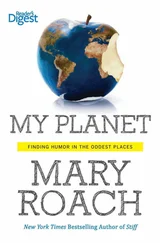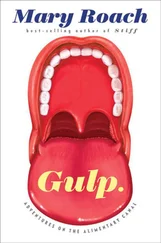One fine fall day, I decided to visit my final resting place. The Brain Bank is part of Harvard’s McClean Hospital, which sits on a rolling estate of handsome brick buildings just outside Boston. I was directed to the third floor of the Mailman Research Building. The woman pronounced it “Melmon,” so as to avoid having to answer stupid questions about what kind of research is being done on mailmen.
If you are considering becoming a brain donor, the best thing for you to do is stay away from the Brain Bank. Within ten minutes of arriving, I was watching a twenty-four-year-old technician slice a sixty-seven-year-old brain. The brain had been flash-frozen and did not slice cleanly. It sliced as does a Butterfinger, with little shards crumbling off. The shards quickly thawed and looked less Butterfingerlike. The technician wiped them up with a paper towel. “There goes third grade.” He has gotten in trouble for saying things like this. I read a newspaper story in which the reporter asked him if he planned to donate his brain and he replied, “No way! I’m going out with whatever I came in with!” Now when you ask him, he says quietly, “I’m only twenty-four, I really don’t know.”
A Brain Bank spokesman showed me around. Down the hall from the dissection room was the computer room. The spokesman referred to this as “the brains of the operation,” which in any other operation would have been fine, but in this case was a tad confusing. At the end of the hall were the real brains. It wasn’t quite what I imagined. I had pictured whole intact brains floating in glass jars. But the brains are cut in half, one side being sliced and frozen, the other side sliced and stored in formaldehyde inside Rubbermaid and Freezette food savers. Somehow, I’d expected more of Harvard. If not glass, at least Tupperware. I wondered what the dorms look like these days.
…The spokesman assured me that no one would even be able to tell that my brain was missing. He assured me in a way that assured me and at the same time didn’t bring me a lot closer to being a committed brain donor. “First,” he began, “they cut the skin like this and pull it up over the face.” Here he made a motion as though taking off a Halloween mask. “They use a saw to cut the top of the skull off, the brain is removed, and the skull is put back and screwed in place. Put the skin flap back, and comb the hair back over.” He used the peppy how-to language of an infomercial host, making brain harvesting sound like something that takes just minutes and wipes clean with a damp cloth….
Yet again, I backed off from my plan. Not so much because of the harvesting process—as you may have gleaned, I’m not a squeamish individual—but because of my mistaken expectations. I wanted to be a brain in a jar, at Harvard. I wanted to look atmospheric and fascinating on a shelf. I didn’t want to spend the hereafter as cut-up pieces in a storeroom refrigerator.
There is but one way to be an organ on a shelf, and that is to be plastinated. Plastination is the process of taking organic tissue—a rosebud, say, or a human head—and replacing the water in it with a liquid silicone polymer, turning the organism into a permanently preserved version of itself. Plastination was developed by German anatomist Gunther von Hagens. Like most plastinators, von Hagens makes educational models for anatomy programs. He is best known, however, for his controversial plastinated whole-body art exhibit, “Körperwelten”—or, in England, “Bodyworlds”—which has toured Europe for the past five years, raising eyebrows and tidy sums of cash (attendance to date is over eight million). The skinless bodies are posed as living people in action: swimming, riding (plastinated horse included), playing chess. One figure’s skin flies out behind it like a cape. Von Hagens cites as inspiration the works of Renaissance anatomists such as Andreas Vesalius, whose De Humani Corporis Fabrica featured bodies drawn in active human poses, rather than lying flat or standing arms to the side, à la the typical medical illustration. A skeleton waves hello; a “muscle man” gazes at the view from a hilltop of the town below.
“Körperwelten” raises the ire of church fathers and conservatives wherever it opens, mainly on the grounds of violated dignity. Von Hagens counters that the bodies in the show were donated by their owners specifically for this purpose. (He leaves a stack of donor forms at the exit of the exhibit. According to a 2001 London Observer article, the donor list is up to 3,700.)
Most of von Hagens’s bodies are plastinated in China, in an operation called Plastination City. He is said to employ two hundred Chinese in what sounds to me like a sort of cadaver sweat shop. This is not all that surprising, as his technique is extremely labor-intensive and time-consuming—it takes over a year to plastinate one individual. (The U.S. version of the technique, modified by Dow Corning after von Hagens’s patent expired, takes one tenth the time.) I contacted von Hagens’s office in Germany to see if I could visit Plastination City and see what kind of shenanigans are in store for a donor body, but von Hagens was on the road and did not return my e-mails in time.
Instead of China, I traveled to the University of Michigan Medical School, where anatomy professor Roy Glover and plastination chemicals manufacturer Dan Corcoran, who worked with Dow Corning to update the technique, have been plastinating whole dead bodies for a museum project of their own, called “Exhibit Human: The Wonders Within”—slated to open in San Francisco in mid-2003. Theirs is strictly educational: twelve plastinated (Corcoran prefers the term “polymer-preserved”) bodies, each displaying a different system—nervous, digestive, reproductive, etc. (At press date, no U.S. museum had signed up to exhibit “Körperwelten.”)
Glover offered to show me how plastination works. We met in his office.
Glover has a long face that made me think of Leo G. Carroll. (I had recently seen Tarantula , wherein Carroll plays a scientist who figures out how to make huge, scary versions of harmless animals, e.g. “Guinea pigs the size of police dogs!”) You could tell Glover was a nice guy because a To Do list on a white board on his office wall said: “Maria Lopez, brain for daughter— science fair.” I decided that this was what I wanted to do with my remains. Travel around to classrooms and science fairs, astounding children and inspiring careers in science. Glover took me across the hall, to a storeroom with a wall of shelves crowded with plastinated human pieces and parts. There was a brain sliced like a loaf of bread and a head split in two so that you could see the labyrinths of the sinuses and the deep, secret source of the tongue. You could pick the organs up and marvel at them, for they were completely dry and had no smell. Yet still, they were clearly real and not plastic. For the many disciplines (dentistry, nursing, speech pathology) that study anatomy but have no time for dissection, models like these are a godsend.
Glover took me down the hall to the plastination lab, which was chilly and cluttered with heavy, strange-looking tanks. He began explaining the process. “First the body is washed.” This is done much as it was when the body was alive: in a tub. “This is a body,” said Glover, quite unnecessarily, regarding a figure on its back in the tub.
The man had been in his sixties. He had a mustache and a tattoo, both of which would survive the plastination process. The head was submerged, giving the corpse a disconcerting murder-victim sort of look. Also, the front chest wall had been separated from the rest of the torso and lay off to the side of the body. It looked like a Roman gladiator’s chest plate, or maybe I just found it helpful to think of it that way. Glover said that he and Corcoran planned to reattach it with a hinge on one side, so that it would swing open “like a refrigerator door” to reveal the organs within. (Months later, I saw photos of the exhibit pieces. Disappointingly, someone must have nixed the refrigerator door idea.)
Читать дальше












